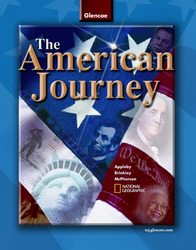The American Journey © 2007Chapter 30:
The Vietnam EraWeb Lesson PlansIntroduction
In this chapter students read about the gradual buildup of American forces in Southeast Asia that led to the Vietnam War. Fighting far from home in a place many of them had never heard of before, American servicemen and women did their best to contain the spread of communism. President Eisenhower had declared that if one country in Southeast Asia fell to communism, others would soon topple, one after another, like a row of dominoes. When the war ended and veterans returned home, most did not find the hero’s welcome they had expected. In this activity, students will take a closer look at the geography, key battles, and returning veterans of the Vietnam War.
Lesson Description
Students will visit a very complete Web site on the Vietnam War maintained by a teacher near Cincinnati, Ohio. Students will read about the geography of Vietnam and its effect on the war, the treatment of returning veterans, and key battles. After answering several questions they will summarize one battle and explain its significance.
Instructional Objectives- The learner will be able to describe the effect geography has on war and history.
- The learner will be able to analyze specific regions of Vietnam.
- The learner will be able to summarize a key battle and explain its significance.
Student Web Activity Answers- Vietnam is located in Southeast Asia just above the Equator. It is subtropical and has heavily forested mountains, small hills, and plains. It has wide jungle-like regions, coastal plains, and river deltas.
- It was often impassable for vehicles and hard going on foot. There were booby trapped dikes, deep ditches, leeches, insects, and extreme heat.
- Soldiers were on a two-year cycle of service, so while many returned home when their cycles were up, the country did not celebrate because we were still at war. Some veterans protested the war upon their return, which influenced public opinion, and many Americans opposed the war because of the killing of civilians that they saw on television. Respect for veterans suffered further when reports of widespread drug abuse among troops became known.
- The Tet offensive turned many Americans against the war.
- Students' battle summaries will vary but should accurately reflect information from the Web site.
 | 




